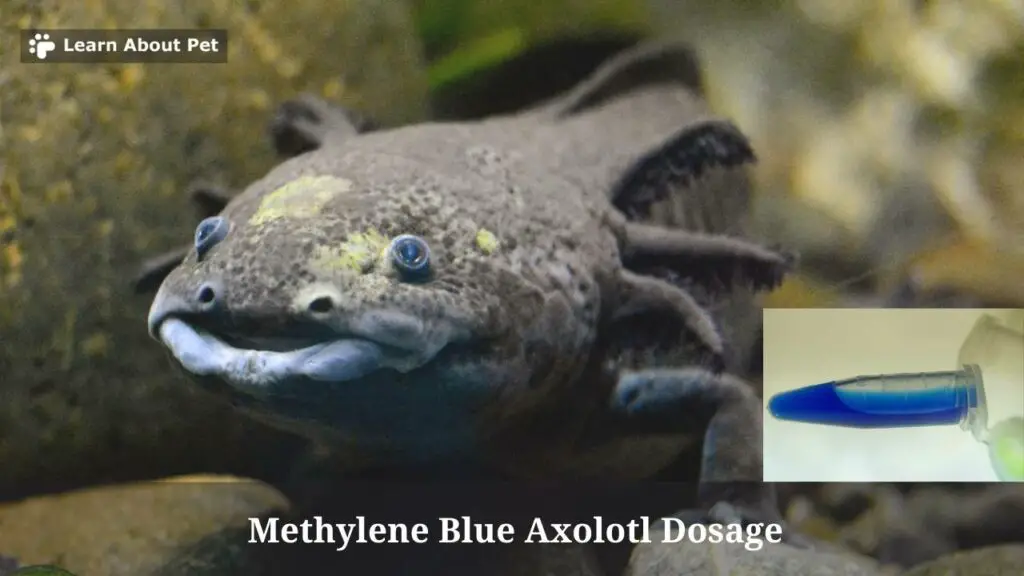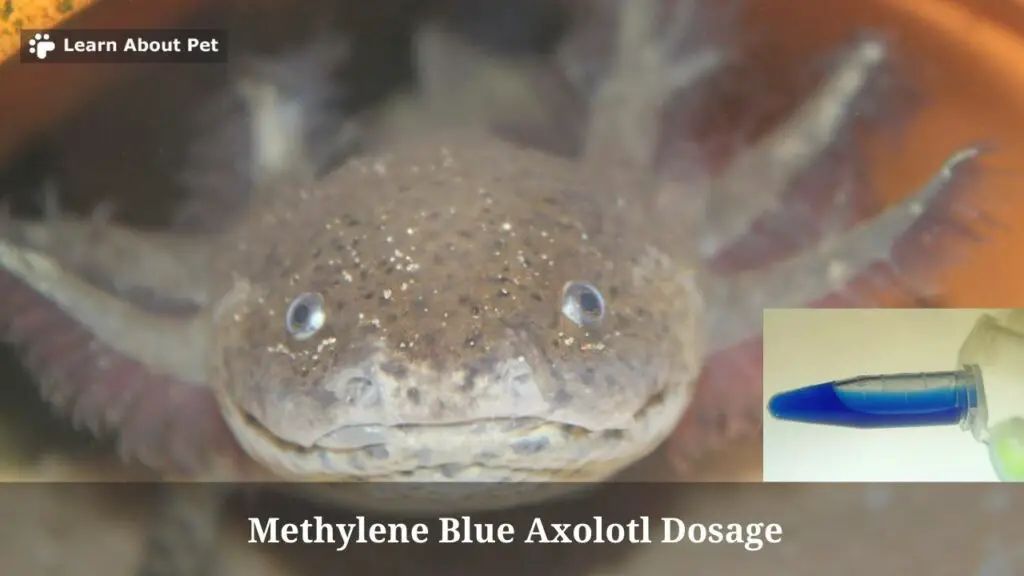Having an axolotl in good health is a dream for all aquatic pet owners. Providing a proper diet, excellent water requirements, and a cozy environment will make the axolotl feel at home in the tank without any problems.
But sometimes, some things can go sideways and make the axolotl experience bacterial, fungal, or protozoan infections. One way to overcome this is to use Methylene blue.
What is the correct Methylene blue axolotl dosage? Methylene blue is not harmful to axolotls if used in low doses. Stay with 1/2 of the fish dosage. Use 2-4 drops of Methylene blue, soak the water for 12 hours, do the axolotl medicinal bath and repeat daily for 3 days. Give a day off to see the reaction of the axolotl’s body, if there is still infection, repeat the process until the axolotl heals.

We can not carelessly use Methylene blue because in general, it is toxic to amphibians. Let’s read this article to the end.
What Are the Signs Of A Sick Axolotl?
A sick axolotl will show several different behaviors or body shapes, such as curled tail tip, loss of appetite, floating, white or black spots in axolotl’s skin, or red skin due to chemical burns.
The most common traits are the axolotl refuses to eat and is unresponsive. Feed the axolotl with the same portion every day. If the axolotl won’t eat properly, try to direct the food in front of the axolotl’s mouth.
White and black spots are the symptoms when axolotl gets fungus when the aquarium is not set up or maintained properly. If the fungal infection is left untreated, it can spread and kill an axolotl. Keep the water condition in the axolotl tank clean, don’t let the axolotl get fungus, and always pay attention to the axolotl’s body if it’s exposed to fungus, even if it’s still a little.
Can Axolotl Get Skin Problems?
The cause of the axolotl skin conditions is that the owner cannot maintain the water condition to the axolotl’s requirements. The most common problems are that axolotls get bacterial infections and may also suffer from gills deterioration.
Although the axolotl can regenerate, bacteria can spread when the axolotl’s body is injured and cause a severe infection. Axolotls can also get protozoan or fungal infections which cannot be underestimated.
If the axolotl tank experiences an ammonia spike, the axolotl’s skin becomes red as if it were burning due to ammonia poisoning. If left with such severe conditions, the axolotl’s life could not be saved.
How To Treat Axolotl Skin Problems?
If you have any doubts about self-medicating, you should seek advice from an exotics veterinarian to seek help on an axolotl’s problems.
Be careful if you use chemicals because amphibians can absorb chemicals directly into their skin and poison or overdose your axolotl.
Several home remedies are tea baths or salt baths. Do it in another tank and repeat the salt or tea baths procedure for up to seven days or if there are signs of a recovery.
What If Axolotl Gets Fungal Infections?
The fungus can be seen directly as fluffy, cotton-like on the axolotl’s body, usually at the wound site or axolotl’s gills. The axolotl fungus can spread to other parts of the body and cause white spots all over the axolotl’s body.
If there is fungus on the axolotl’s gills, there will be signs of erosion on the filaments, white patches, and degeneration.
Some owners will do a salt bath to get rid of the fungus, but some use Methylene blue as a medicinal bath.
But you should know that the Methylene blue axolotl dosage must be lower than that of fish because axolotls are amphibians that absorb chemicals into their skin.
Do Axolotls Get Stress When They Get Fungal Infections?
Any health issues will show axolotl stress signs, such as lack of appetite, looking uncomfortable, wanting to scratch certain body parts, curled gills, and being unresponsive. Do the fridging method to reduce pain from infection.
If you don’t know how to fridge your axolotl, immediately take it to an exotics veterinarian to resolve fungal infections on your vet.
Axolotls that start to get stressed will float a lot and feel uncomfortable being in the tank. Check to see cotton-like and fluffy things on the gills or other parts of the body.

Fungus Treatment For Axolotl
The axolotl fungus treatment is needed starting from the beginning of your axolotl getting fungus to prevent fungal infections that will spread to other parts of the body. The table below are treatments that can be used to treat fungal infections.
| Treatment | Explanation |
| Salt bath | Salt-water solution by bathing for a couple of minutes daily and up to 7 days. |
| Tea bath | Black tea and boiling water. Allow the tea to stew and the room temperature water before getting axolotl to bathe inside it. |
| Methylene blue | One of the chemicals for medicinal baths, but can only be used in low dosages. |
| Indian almond leaves | Can help fight off fungal infections in minor conditions. |
Protozoan And Bacterial Infections In Axolotl
Hexamita is a protozoan infection that can only be seen from a microscope analysis of fecal matter. Hexamita resides in the axolotl’s intestines. You can take Metronidazole and add it to axolotl’s food.
For bacterial disease, there is columnaris which is identical to fungus. Columnaris will make white patches or fluffy gray on the axolotl’s body and stress the axolotl. Many treatments can be done for columnaris, such as salt baths, antibiotics, or tea baths.
Can We Use Methylene Blue For Axolotl?
Methylene blue is safe if you know that the Methylene blue axolotl dosage is not the same as the dose to be given to fish. Give 1/2 the usual you give to fish because Methylene blue is safe for axolotls at the minimum dose.
Never increase the dosage over time because aquatic amphibians can absorb medications even though the bath is in a large area. Although the Methylene blue does not work on all protozoan species, it still works on fungal or internal infections.
How Much Methylene Blue Dosage Is Safe For Axolotl?
Use dechlorinated water mixed with 2-4 drops of Methylene blue until the water is a light sky blue. Do not immediately put the axolotl into the tank because it must be soaked for 12 hours. Perform Methylene blue bath 3 times per day for a maximum of 3 days until the fungus disappears from the axolotl’s body.
Are There Any Other Alternatives To Methylene Blue For Axolotl?
Yes. You can use aquarium salt, Indian almond leaves, or a tea bath. Tea bath using a tub with 1/2 gallon of dechlorinated water. Use 1 cup of 100% black tea and allow it to cool. Add the tea to the tub, and put the axolotl in it.
Soak for 10-15 minutes, and put the axolotl back into another tub of cool dechlorinated water. Use the same tea bath 3 times a day for a max of 3 days.
Final Verdict – Methylene Blue Axolotl Dosage
Fungal infections can occur when the water conditions in the axolotl tank are dirty and not maintained. Even if you put a filter in the aquarium, the aquarium’s condition can get dirty faster when the axolotl produces a lot of waste or uneaten food that can increase the ammonia level.

If the tank’s condition is bad, the axolotl can develop fungal, bacterial, or protozoan infections.
You can do several treatments such as salt baths, tea baths, or Methylene blue baths with low dosages. Use 2-4 drops of Methylene blue, put the axolotl in the tub, and do the same process 3 times a day until 3 days later.
As a pet lover, make sure to learn about pet more and give your pet axolotl a good and comfortable life!

Welcome to Learn About Pet. My name is Rajkumar Ravichandran and I love all pets, travel, and amazing food. I write about my passion and personal experience caring for multiple pets in this blog! ❤️
Post Disclaimer
DISCLAIMER: THIS BLOG OR WEBSITE, "Learn About Pet", DOES NOT PROVIDE YOU WITH MEDICAL ADVICE AND IS NOT A SUBSTITUTE FOR MEDICAL ADVICE. ALWAYS GET IN TOUCH WITH YOUR PERSONAL VETERINARIAN AND USE INFORMATION HERE AS GENERAL ADVICE.
The information, including but not limited to, text, graphics, images and other material contained on this website are for informational purposes only. No material on this site is intended to be a substitute for professional veterinary advice, food recommendation, diagnosis, or treatment. Always seek the advice of your veterinarian or other qualified health care provider with any questions you may have regarding a medical condition or for pet food related questions.







